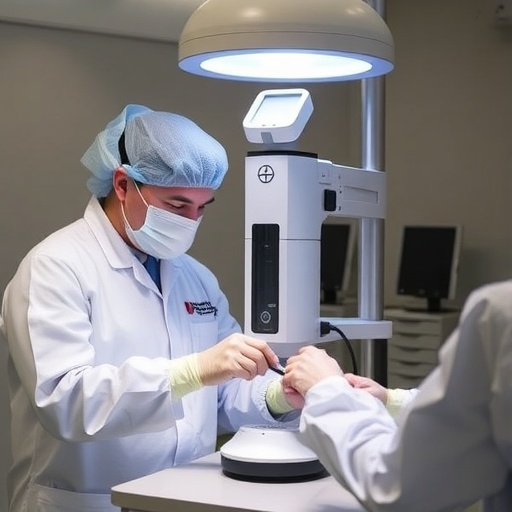
In the relentless battle against recurrent ovarian cancer, researchers are exploring innovative approaches beyond the traditional chemotherapy regimens that have long dominated treatment. A groundbreaking multicenter clinical trial known as SABR-ROC (Stereotactic Ablative Radiation Therapy for Recurrent Ovarian Cancer) is investigating the efficacy of stereotactic ablative radiation therapy (SABR), a precision-focused radiation method, as a novel therapeutic avenue to improve patient outcomes. The rigor and accuracy of such trials hinge critically on uniformity and adherence to protocols across participating centers, a challenge that the latest study published in BMC Cancer meticulously addresses through a comprehensive radiotherapy quality assurance program.
The SABR-ROC study, registered with ClinicalTrials.gov under the identifier NCT05444270, represents a phase III prospective, randomized, multicenter trial, aiming to standardize SABR applications in recurrent ovarian cancer with the ambitious goal of balancing treatment effectiveness while minimizing toxicity. Recognizing that stereotactic radiotherapy demands exacting precision—especially in complex anatomical sites—the researchers conducted a dummy run study focused on assessing the consistency and quality of treatment plans across 10 diverse clinical centers involved in the trial.
This dummy run, a trial within the trial, challenged radiation oncologists with four representative clinical cases characterized by distinct anatomical complexities and tumor localizations. Each case simulated different metastatic sites including lymph nodes, lung metastases, intraperitoneal spread, and liver seeding—each presenting unique delineation challenges. The core purpose was to evaluate how consistently clinicians could delineate tumor volumes and generate treatment plans in line with the rigorous SABR-ROC protocol, which outlines explicit dose prescriptions and organ-at-risk constraints.
.adsslot_bxst0Hj1ok{width:728px !important;height:90px !important;}
@media(max-width:1199px){ .adsslot_bxst0Hj1ok{width:468px !important;height:60px !important;}
}
@media(max-width:767px){ .adsslot_bxst0Hj1ok{width:320px !important;height:50px !important;}
}
ADVERTISEMENT
The researchers employed the Dice similarity coefficient—a statistical measure widely used in medical imaging to quantify spatial overlap—as a metric for agreement in target volume delineation. The findings revealed a sobering reality: overall concordance was notably low. Gross tumor volume (GTV) and planning target volume (PTV) agreements averaged merely 0.278 and 0.255 respectively, indicating significant variability in how clinicians identified and defined tumor boundaries. While agreement was relatively better in cases involving lymph node and lung metastases, it diminished sharply in scenarios involving intraperitoneal and hepatic metastases, pointing to the intrinsic difficulty in accurately mapping microscopic disease spread within complex abdominal environments.
Beyond target delineation, the study probed treatment plan adherence to prescribed dose parameters. Encouragingly, most centers succeeded in aligning their plans with the predefined dose goals. Minor deviations in PTV coverage emerged, particularly where multiple small metastases complicated the radiation fields, potentially reflecting cautious optimization to spare adjacent critical structures. However, a recurrent and clinically significant issue was frequent violation of organ-at-risk constraints, especially concerning the small bowel—a radiosensitive organ prone to serious complications if overdosed. These findings underscore the delicate balance between delivering ablative doses sufficient for cancer control and preserving normal tissue integrity.
This variability in both tumor contouring and treatment planning not only threatens the internal validity of the SABR-ROC trial but also illuminates broader challenges facing radiotherapy research and clinical practice. Standardization is paramount in radiation oncology trials to ensure that observed treatment effects derive from the intervention itself rather than inconsistencies in execution. The study’s revelations reinforce the necessity of robust quality assurance mechanisms, comprehensive training, and possibly centralized review processes to harmonize practice.
Moreover, the observed discordance underscores the enduring importance of clinician judgment. In complex clinical scenarios where imaging interpretation is equivocal and anatomical relationships intricate, rigid adherence to protocol must sometimes yield to individualized decision-making to optimize patient benefit. Such nuances point towards a future where artificial intelligence-driven contouring tools, integrated with expert oversight, might enhance accuracy and reproducibility without undermining clinical intuition.
The implications of this dummy run extend beyond the SABR-ROC trial alone. They spotlight the inherent challenges in adopting SABR for recurrent ovarian cancer—an oncology niche historically managed predominantly by systemic chemotherapy. SABR’s promise lies in its ability to deliver concentrated, high-dose radiation with sub-millimeter precision, potentially controlling isolated metastases while sparing patients from the cumulative toxicities of repeated chemotherapy cycles. Yet, translating this promise into widespread clinical benefit demands rigorous, protocol-driven consistency verified through robust quality assurance.
The study also hints at anatomical site-specific complexities that may necessitate tailored protocols or adaptive radiotherapy strategies. For tumors in the peritoneal cavity or liver, where lesion boundaries are often indistinct and surrounded by critical organs, enhanced imaging modalities or functional imaging integration may improve delineation accuracy. Similarly, innovative motion management techniques could mitigate the impact of respiratory and organ motion, enhancing the reliability of dose delivery in thoracic and abdominal targets.
Ultimately, the quality assurance outcomes from this dummy run study will inform refinements in training modules, delineation guidelines, and treatment planning rules integral to the ongoing SABR-ROC trial. This iterative process aims to tighten conformity among participating centers, ensuring that the clinical trial yields robust, generalizable data on SABR’s therapeutic value for recurrent ovarian cancer.
As recurrent ovarian cancer remains a formidable clinical challenge with limited curative options, the SABR-ROC trial offers a beacon of hope. By rigorously scrutinizing technical aspects such as target delineation and dose planning early in the trial, researchers safeguard scientific integrity and patient safety, while paving the way for potential paradigm shifts in management. If successful, SABR could complement or even revolutionize standard care paradigms, alleviating the burden of chemotherapy and enhancing patients’ quality of life.
This study exemplifies the transformative potential when multidisciplinary collaboration, advanced technology, and rigorous methodology converge in clinical oncology research. The ongoing SABR-ROC phase III trial, backed by these stringent quality assurance efforts, will be closely watched by the global radiation oncology community for its capacity to inform evidence-based practice and refine SABR application in complex metastatic settings.
In conclusion, the SABR-ROC dummy run study serves as a crucial milestone in the journey towards establishing stereotactic ablative radiation therapy as a viable option for recurrent ovarian cancer. It highlights the intricate interplay between technological capability and human expertise, underscoring the relentless pursuit of precision medicine in oncology. As clinical trial results emerge, they hold promise not only for improved oncologic outcomes but also for personalized, safer treatments that restore hope where recurrence has long elusive control.
Subject of Research:
Radiotherapy quality assurance and treatment planning consistency in stereotactic ablative radiation therapy (SABR) for recurrent ovarian cancer.
Article Title:
Radiotherapy quality assurance program of ongoing clinical trial using stereotactic ablative radiation therapy for recurrent ovarian cancer (SABR-ROC): a dummy run study of a prospective, randomized, multicenter phase III trial (KGOG 3064/KROG 2204).
Article References:
Park, S., Kim, H., Wee, C.W. et al. Radiotherapy quality assurance program of ongoing clinical trial using stereotactic ablative radiation therapy for recurrent ovarian cancer (SABR-ROC): a dummy run study of a prospective, randomized, multicenter phase III trial (KGOG 3064/KROG 2204). BMC Cancer 25, 1336 (2025). https://doi.org/10.1186/s12885-025-13892-9
Image Credits: Scienmag.com
DOI: https://doi.org/10.1186/s12885-025-13892-9
Tags: BMC Cancer publicationclinical trial quality assuranceinnovative cancer treatment approachesminimizing treatment toxicitymulticenter clinical studyphase III cancer trialprecision radiation therapyquality control in radiotherapyrecurrent ovarian cancer treatmentSABR-ROC trialstereotactic ablative radiation therapyuniformity in cancer trials





